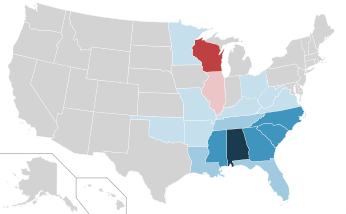Piggly Wiggly facts for kids
 |
|
|
Trade name
|
Piggly Wiggly |
|---|---|
| Subsidiary | |
| Industry | Retail |
| Founded | September 6, 1916 in Memphis, Tennessee, U.S. |
| Founder | Clarence Saunders |
| Headquarters |
,
U.S.
|
|
Number of locations
|
503 (2023) |
|
Areas served
|
Southeast Midwest |
| Products | Bakery, dairy, deli, frozen foods, grocery, meat, pharmacy, produce, seafood, snacks |
| Services | Supermarket |
| Parent | C&S Wholesale Grocers |
Piggly Wiggly is an American supermarket chain found in the Southern and Midwestern parts of the United States. The company, Piggly Wiggly, LLC, is part of C&S Wholesale Grocers.
The first Piggly Wiggly opened in 1916 in Memphis, Tennessee. It became famous for being the first true self-service grocery store. This means it was the first store where shoppers could walk down the aisles and pick out their own items.
Piggly Wiggly also introduced many things we see in supermarkets today. These include checkout stands and putting a price on every single item. Today, the company's main office is in Keene, New Hampshire. There are over 500 Piggly Wiggly stores in 18 states. Most are in smaller cities and towns and are owned by local operators.
Contents
History
Piggly Wiggly was founded by Clarence Saunders on September 6, 1916. The first store was located at 79 Jefferson Avenue in Memphis, Tennessee. You can visit a copy of the original store in the Memphis Pink Palace Museum and Planetarium.
A New Way to Shop
Before Piggly Wiggly, grocery shopping was very different. Shoppers would give a list of items to a store clerk. The clerk would then walk around the store, gathering everything on the list.
Clarence Saunders had a new idea. He wanted to let customers walk through the store and pick out their own items. This was called "self-service." Store owners worried that this would make it easier for people to steal things. However, they found that they made more money because people would buy extra items they saw on the shelves. This is sometimes called "impulse buying."
The Piggly Wiggly company gave out franchises. This allowed hundreds of other business owners to open their own Piggly Wiggly stores. Saunders patented his "self-serving store" idea in 1917.
When customers entered a Piggly Wiggly, they walked through a turnstile. They followed a path through four aisles with about 605 items to choose from. After picking their items, they went to a cashier to pay. Because of this new system, the way products were packaged and branded became much more important.
Success and Problems
The new self-service idea was a huge success. Many other grocery stores copied the Piggly Wiggly model in the 1920s and 1930s. By 1932, there were 2,660 Piggly Wiggly stores.
In 1922, Saunders tried to gain full control of the company's stock on the stock market. This caused problems with the New York Stock Exchange, and he eventually lost control of the company and his fortune.
After this, the company was split up and sold to other large grocery chains like Kroger and Safeway. Saunders was no longer involved with Piggly Wiggly. He continued to be interested in new ways for people to shop until he died in 1953.
Why the Name Piggly Wiggly?
According to the company's website, Clarence Saunders never liked to explain where the name came from. One story says he was on a train and saw several small pigs trying to get under a fence. This made him think of the rhyming name.
When someone asked him why he chose such a strange name, he reportedly said, "So people will ask that very question."
Piggly Wiggly Today
Over the years, Piggly Wiggly was bought and sold by different companies. In 2003, C&S Wholesale Grocers bought the company, and they still own it today.
There are now more than 500 Piggly Wiggly stores in 18 states. Each store is independently owned and operated. This means local business people run their own stores but use the Piggly Wiggly name and products. The company's headquarters is in Keene, New Hampshire.
Gallery
-
Historical marker near the site of the first Piggly Wiggly store in Memphis, Tennessee
-
Historical marker near the site of the first Piggly Wiggly store in Memphis, Tennessee, reverse side
-
A Piggly Wiggly store in Springhill, Louisiana, in August 2011
See also
- Supermarkets in the United States
- Houchens Industries






